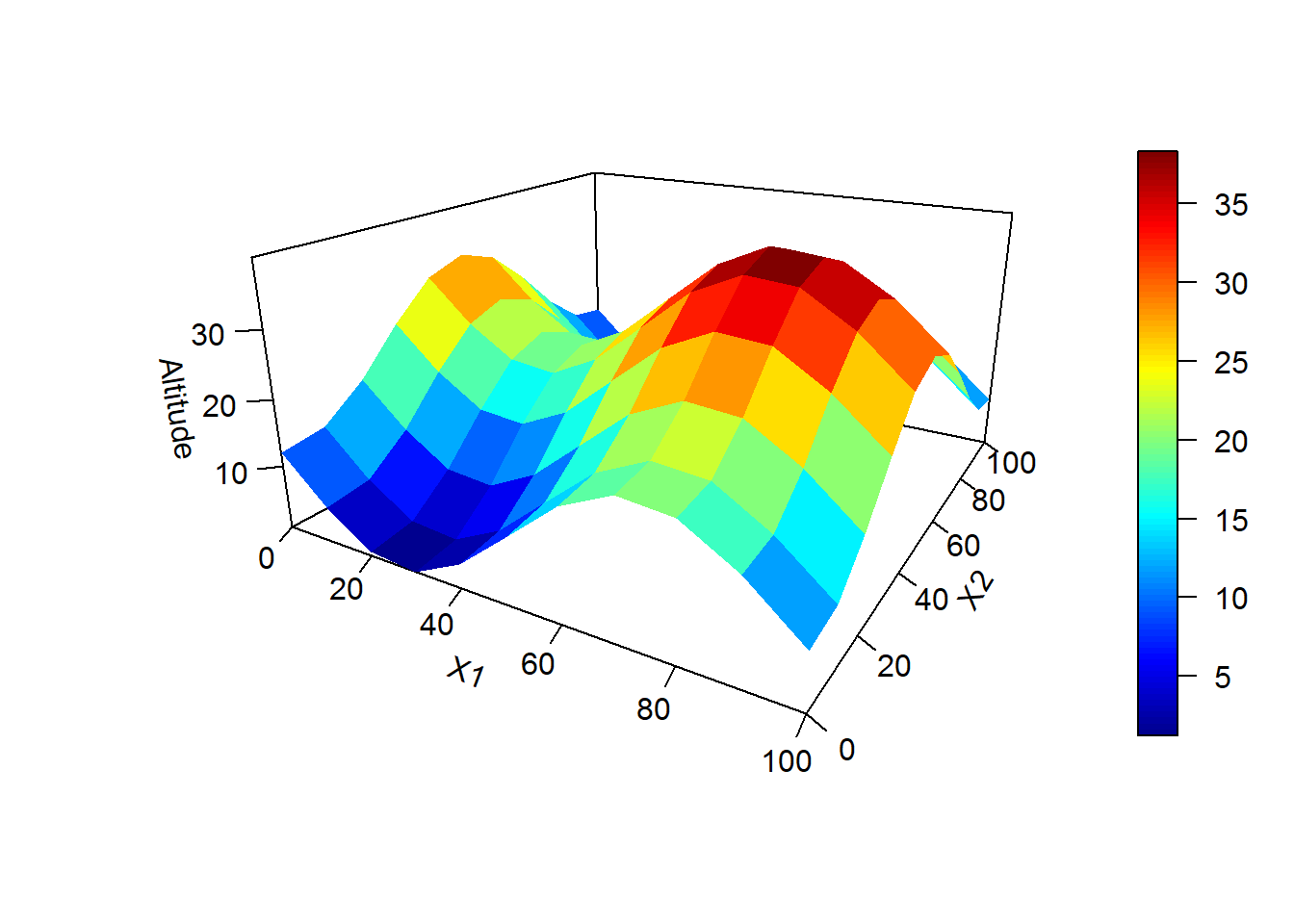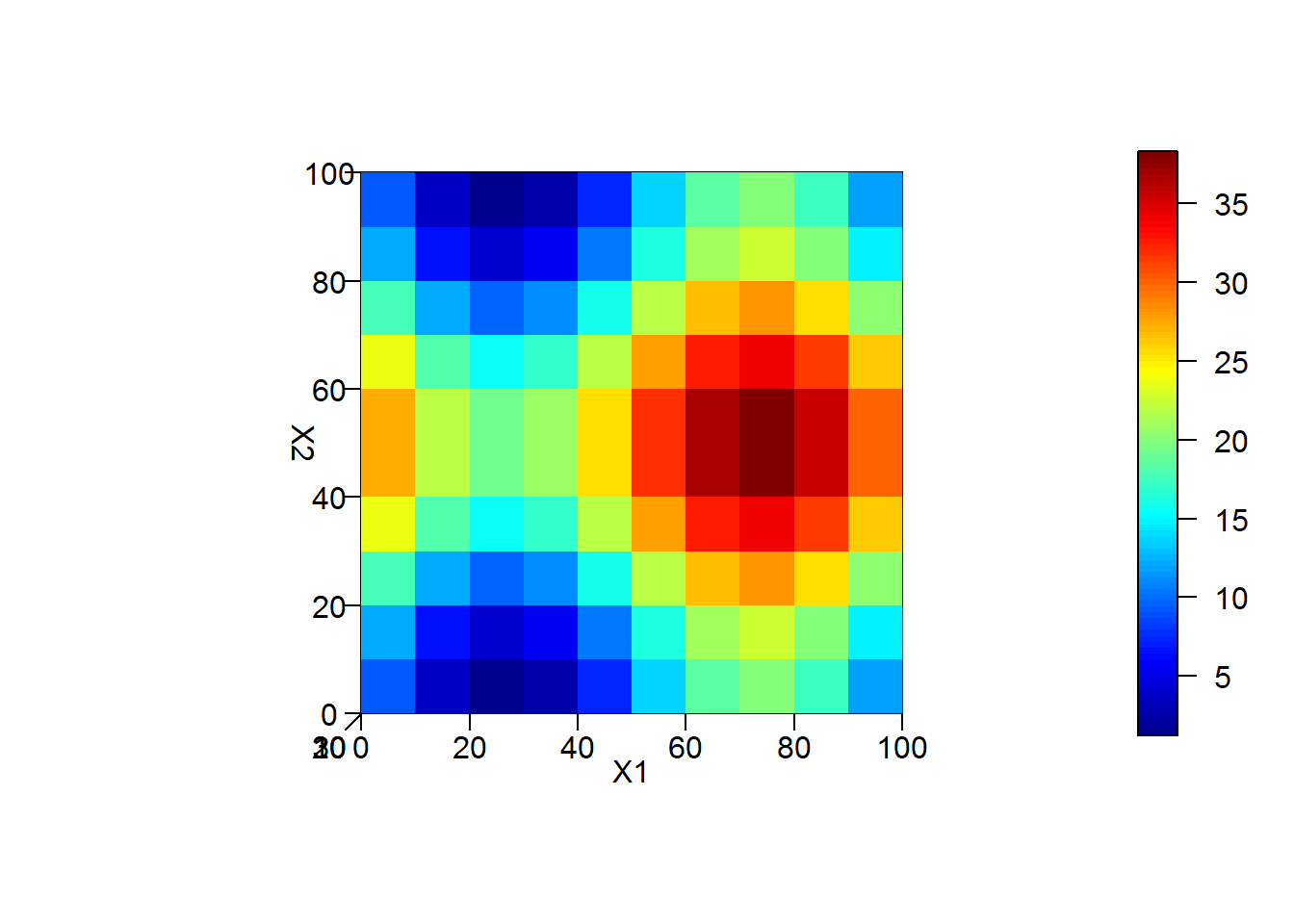Target Encoding with Regularization - How To
library("dplyr")
library("rgl")
library("plot3D")
printf = function(...) cat(sprintf(...))
# BEGIN OF SUPPORT FUNCTIONS
# Reference:
# https://github.com/skranz/dplyrExtras/blob/master/R/s_dplyr.r
s_filter = function(.data, ...) { eval.string.dplyr(.data,"filter", ...) }
s_select = function(.data, ...) { eval.string.dplyr(.data,"select", ...) }
s_arrange = function(.data, ...) { eval.string.dplyr(.data,"arrange", ...) }
s_mutate = function(.data, ...) { eval.string.dplyr(.data,"mutate", ...) }
s_summarise = function(.data, ...) { eval.string.dplyr(.data,"summarise", ...) }
s_group_by = function(.data, ...) { eval.string.dplyr(.data,"group_by", ...) }
eval.string.dplyr = function(.data, .fun.name, ...) {
args = list(...)
args = unlist(args)
code = paste0(.fun.name,"(.data,", paste0(args, collapse=","), ")")
df = eval(parse(text=code,srcfile=NULL))
df
}
# END OF SUPPORT FUNCTIONS
Imagine there is a city like in the image below. This city is divided into multiple areas: zip codes. The altitude of this city changes depending on the location. Each zip code has 10 x 10 = 100 houses.
regions_per_dimension = 10
x1_plot = seq(0, 100, length = regions_per_dimension + 1)
x2_plot = seq(0, 100, length = regions_per_dimension + 1)
x1 = seq(0, 100, length = 100)
x2 = seq(0, 100, length = 100)
h = function(x1, x2) 10 * sin((x1 - 50) / 15) + 10 * cos((x2 - 50) / 15) + (10 + 10)
persp3D(
x1_plot,
x2_plot,
outer(x1_plot, x2_plot, h),
xlab = "X1",
ylab = "X2",
zlab = "Altitude",
ticktype = "detailed",
theta = 30,
phi = 20,
expand = 0.5
)
On the image below you have better view about the different zip codes on the city, where each square corresponds to one zip code:
persp3D(
x1_plot,
x2_plot,
outer(x1_plot, x2_plot, h),
xlab = "X1",
ylab = "X2",
zlab = "",
ticktype = "detailed",
theta = 0,
phi = 90,
expand = 0
)
Let’s get the observations on a dataframe.
As you can see each zip code will be formatted as: 1[X1][X2] , where: X1 , X2 : { 01 , …, 10 } (both with two digits).
len = 100
x1 = x2 = alt = zip = rep(0, len ^ 2)
for (x2i in 0:(len-1)) {
for (x1i in 0:(len-1)) {
i = x2i * len + x1i + 1
x1[i] = x1i
x2[i] = x2i
alt[i] = h(x1i, x2i)
zip[i] = sprintf("%d", 10000 + (floor(x1i/10)+1)*100 + (floor(x2i/10)+1))
}
}
df = data.frame(altitude = alt, x1 = x1, x2 = x2, zip = zip)
df$zip = as.factor(df$zip)
df = df %>% arrange(zip) # just putting observations (houses) with same zip together
# View(df)
str(df)
## 'data.frame': 10000 obs. of 4 variables:
## $ altitude: num 12.09 11.43 10.77 10.1 9.43 ...
## $ x1 : num 0 1 2 3 4 5 6 7 8 9 ...
## $ x2 : num 0 0 0 0 0 0 0 0 0 0 ...
## $ zip : Factor w/ 100 levels "10101","10102",..: 1 1 1 1 1 1 1 1 1 1 ...
summary(df)
## altitude x1 x2 zip
## Min. : 0.00461 Min. : 0.00 Min. : 0.00 10101 : 100
## 1st Qu.:12.06935 1st Qu.:24.75 1st Qu.:24.75 10102 : 100
## Median :19.64418 Median :49.50 Median :49.50 10103 : 100
## Mean :19.44756 Mean :49.50 Mean :49.50 10104 : 100
## 3rd Qu.:26.63075 3rd Qu.:74.25 3rd Qu.:74.25 10105 : 100
## Max. :39.99574 Max. :99.00 Max. :99.00 10106 : 100
## (Other):9400
Here there is a random sample of our observations:
Getting a seed first:
# seed_sample = (1:1000000)[sample(1000000,1)]
seed_sample = 636889
printf("seed_sample: %d", seed_sample)
## seed_sample: 636889
Getting the sample of the dataset:
set.seed(seed_sample)
df_preview = df[sample(1:nrow(df), 20),]
rownames(df_preview) = NULL
print(df_preview)
## altitude x1 x2 zip
## 1 18.172164 15 35 10204
## 2 23.217744 39 52 10406
## 3 26.650505 1 65 10107
## 4 37.851856 73 60 10807
## 5 26.627905 8 51 10106
## 6 36.384171 62 44 10705
## 7 9.467518 4 94 10110
## 8 33.967755 88 59 10906
## 9 4.453650 41 5 10501
## 10 6.745105 45 98 10510
## 11 3.070652 36 10 10402
## 12 35.357103 75 35 10804
## 13 10.835880 13 78 10208
## 14 37.597349 77 40 10805
## 15 3.751946 13 3 10201
## 16 13.439950 1 87 10109
## 17 34.826192 74 66 10807
## 18 24.482611 86 77 10908
## 19 17.024661 8 27 10103
## 20 9.762171 28 26 10303
GOAL
Use an appropriate encoding for the zip code.
Since the zip code is a discrete variable with a high cardinality (on this dummy example only 100 levels, but on a real example could be much more), I want to use Target Encoding (aka: Mean Encoding ) for it.
The following is one possible implementation:
myeval = function(code, envir = NULL) {
eval(parse(text = code), envir = envir)
}
regularize_encoding = function(dataset, varname, encoding) {
# ...
# TODO / TBD / ATTENTION: This function is pending to be implemented
# ...
return (encoding)
}
target_encoding_with_regularization = function(dataset, varname) {
encoding = dataset %>% s_group_by("zip") %>% summarize(encoding = mean(altitude)) %>% arrange(desc(encoding))
encoding = data.frame(encoding)
rownames(encoding) = encoding[,1]
encoding = myeval(
sprintf("encoding %%>%% select(-%s)", varname),
envir = environment()
)
encoding = regularize_encoding(dataset, varname, encoding)
dataset = myeval(
sprintf('dataset %%>%% mutate(%s_encoded = encoding[%s, "encoding"])', varname, varname),
envir = environment()
)
return (list(
dataset = dataset,
encoding = encoding
))
}
dataset_encoding = target_encoding_with_regularization(df, "zip")
This is the encoding we got:
print(head(dataset_encoding$encoding, 10))
## encoding
## 10806 39.17764
## 10805 38.96352
## 10706 37.45907
## 10705 37.24496
## 10906 36.70025
## 10905 36.48613
## 10807 35.37535
## 10804 34.82470
## 10707 33.65678
## 10704 33.10613
print(tail(dataset_encoding$encoding, 10))
## encoding
## 10409 5.0252593
## 10402 4.5520796
## 10309 3.7229025
## 10210 3.4631097
## 10201 3.3707622
## 10302 3.2497227
## 10410 1.8986943
## 10401 1.8063469
## 10310 0.5963374
## 10301 0.5039900
And this is a sample of the dataset with: zip_encoded :
set.seed(seed_sample)
df_preview = dataset_encoding$dataset[sample(1:nrow(dataset_encoding$dataset), 20),]
rownames(df_preview) = NULL
print(df_preview)
## altitude x1 x2 zip zip_encoded
## 1 18.172164 15 35 10204 32.066372
## 2 23.217744 39 52 10406 22.296000
## 3 26.650505 1 65 10107 35.375349
## 4 37.851856 73 60 10807 11.924771
## 5 26.627905 8 51 10106 36.486134
## 6 36.384171 62 44 10705 15.866747
## 7 9.467518 4 94 10110 33.106134
## 8 33.967755 88 59 10906 8.999222
## 9 4.453650 41 5 10501 21.506546
## 10 6.745105 45 98 10510 20.038284
## 11 3.070652 36 10 10402 23.965454
## 12 35.357103 75 35 10804 12.397951
## 13 10.835880 13 78 10208 28.533516
## 14 37.597349 77 40 10805 12.040783
## 15 3.751946 13 3 10201 32.897961
## 16 13.439950 1 87 10109 33.656784
## 17 34.826192 74 66 10807 11.924771
## 18 24.482611 86 77 10908 6.720130
## 19 17.024661 8 27 10103 37.459070
## 20 9.762171 28 26 10303 27.466335
Small issue to solve: The zip code: 10805 was encoded as: 38.96352 , but above is showing up as: 12.040783 . Working on that in the meantime.
My Question:
Is there any library that let me do the same encoding as before and at the same time doing: Regularization to prevent overfitting?
All the documentations out there talk about Regularization is necessary to prevent overfitting, but couldn’t find a really clear example about how to do it in R .
If possible, could you please, provide the lines of code here?, I think this can be done with few lines maybe using the proper libraries (I’m pretty sure there is already some package to achieve this).

